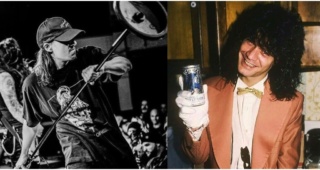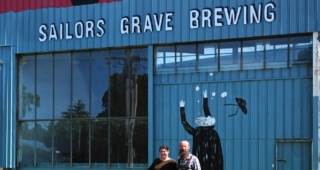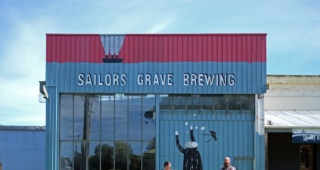Mixed fermentation beer is a funny thing.
When done well, it’s an exceptionally satisfying, oftentimes complex, and understated thing; a beer that can make one think differently about what beer is and can be. On the brewer’s end it’s a calculated risk type of thing; a controlled experiment that tempts volatility with a living cocktail of yeasts and bacteria and wort and usually wood. And when the day calls for a blending of two or more mixed fermentation beers, brewers can no longer just bet on the ingredients and vessels she or he thinks will produce the desired result. Blending introduces an acid test of one’s palate, creativity, and ability to deftly identify that combination of beers that will come together like Voltron and become one formidable whole.
It is on these occasions that distinctions between winemakers and brewers become almost negligible.
On the beer drinker’s end, mixed fermentation beer is usually a pricey thing for more reasons than one, a topic we need not explore much here. However, consider the difference in time, effort, and costs between, say, a largely mechanized, high-volume pale ale, and those of a bespoke blend of several small-batch ales that have rested for many months or many years in old wine and/or liquor barrels. Consider that the bespoke blend will never be exactly replicated again.
In developing good beer destinations like Singapore and Australia, mixed fermentation beer is still something of a rare thing, though increasingly less so as we march towards a new decade and new age of what we might call “beer awareness.” (I’m not sure I love the term, but let’s go with it for now.) More and more brewers across Asia-Pacific have begun dabbling in mixed fermentation, and more and more importers are sourcing these beers from the mixed fermentation hotbeds that are the United States and Europe.
Related: In Byron Shire, a Village Brewery Soaking Up the Thirsts of the Land
I think well-done mixed fermentation beers are one of the most approachable styles out there. I’ve yet to meet anyone who didn’t like them once they tried them. But the funny thing about mixed fermentation beer is that it just sounds so unapproachable. Mixed fermentation ale sounds “beer geeky” (sorry to dip into over-trodden cliché, but it feels apropos here) and a little snooty to the casual beer drinker, in part because the casual beer drinker drinking outside The Craft Beer Bubble, particularly in Asia-Pacific, probably has no idea what the fuck it is.
To be clear, and to break down description of mixed fermentation to brass tacks, it is simply a beer fermented with a mix of different yeasts and bacteria; in contrast, a single yeast is most commonly used in beer fermentation. The beer often then ferments, or ages, in wood, usually a retired wine barrel or foudre (large wooden vat). There are several nuances or subcategories of mixed fermentation beer—spontaneous fermentation, open-air fermentation, etc—but that’s the gist of it. I’m trying not to make it sound so unapproachable and esoteric, after all.

Honestly, though, mixed fermentation beer is a little esoteric. And if a casual beer drinker peeked into a recent media tasting at Temple Cellars of Wildflower Brewing & Blending’s Australian wild ales, and saw those 750ml bottles being gently, lovingly poured into glasses from a wine cradle… well, who would blame him for considering the whole thing highfalutin foolery for the bearded beer bros?
It isn’t, of course. Mixed fermentation beer is a wonderful thing, an incredibly accessible thing, a thing that deserves broader acceptance and understanding and adoption. And it is on its producers, like Sydney’s Wildflower, to be the most vocal evangelists and help dispel any notions of mixed fermentation beer as a thing only for the hardcore beer people.
Topher Boehm, an American expat with an astrophysics background and stints brewing at places like Flat Rock Brew Café, Jester King, and Batch Brewing, co-founded Wildflower in 2017 with brother-in-law Chris Allen. It is based in Marrickville, an Inner West Sydney suburb that has become in recent years the city’s undisputed center of craft brewing—Batch, Sauce Brewing Co, Willie the Boatman, and Young Henrys are just a few of the award-winning breweries located here.
Related: In Margaret River Wine Country, Bloody Good Fun with Beer at Rocky Ridge Brewing
Rather than brew its own wort onsite—wort, of course, is the sugar-saturated liquid that will later become beer once yeast is introduced—Wildflower commissions it from Batch Brewing. The mixed fermentation magic begins once Boehm gets his hands on Batch’s deliveries. Armed with a mix of yeast cultures foraged locally in New South Wales, Boehm quarantines the wort with handpicked yeasts in retired oak wine barrels to ferment for, well, as long as he wishes it to ferment.
At Temple Cellars, for instance, we try Wildflower’s Gold – Blend #17, a combination of ales from four different barrels that have aged between four and 14 months. The blend was then naturally conditioned through refermentation for another 21 weeks prior to bottling. There is also Amber – Blend #20, a blend of four ales aged between seven and 10 months and then refermented for 24 weeks. There are more than blends, however. Daily Bread – Batch #2, for instance, is a single ale with 30-percent of its malt bill drawn from unused sourdough from ester, a popular restaurant located in Sydney’s Chippendale neighborhood.

In all, on its first shipment Wildflower sent to Singapore nine different beers across roughly 500 large-format 750ml bottles, which Temple Cellars debuted in September 2019. Each beer showcases its own distinctive aroma and flavor, but the differences are subtle, particularly between the blends of Gold and Amber, and the pulls of Solera, an unblended spelt beer aged in a foudre. Commonalities we generally find in these beers, however, are sneaky stone fruit aromas, balanced acidity, and earthy and mildly funky flavors. The Gold varieties finish with a pleasantly light tart sparkle, while the well-rounded Ambers offer a nuttier, breadier, more savory profile.
Wildflower Brewing & Blending is one of the only Australian breweries focused on mixed fermentation, and we’re genuinely excited about its early returns and potential as a catalyst for wider regional appreciation of this special style of beer. In the end, after all, mixed fermentation is but a didactic descriptor—it’s really just good beer.
We catch up with Boehm over email for five quick questions on Wildflower, its splash in Singapore, and his occasionally loquacious missives on the brewery blog.

Beer Travelist: How many barrels are currently in use, and what are your plans and/or hopes for growing the program? Do you at some point want to brew the base beers yourself?
Topher Boehm: We have around 200 small-format oak barrels and three large-format foudres. This is probably the limit in our space, and at this point I’m happy with that. I am not driven in the common sense by growth; I’m more focused on the beer. I would rather make a small amount of high quality beer than a bunch of mediocre stuff.
In terms of brewing in our space… maybe. Making wort doesn’t interest me as much as it does your normal brewer. I am more focused on fermentation. I also like, for some weird reason, that the process of making wort isn’t that easy. I am more intentional about what I am brewing this way.
BT: Are there any particularly unique qualities about the mixed culture yeasts upon which you’ve settled? Is there something specific, something tangible, to New South Wales about them?
Boehm: I couldn’t say specifically there is something endemic to NSW in the culture, but I can say it is from here, though. The process and reason behind using local yeast was and is less about exploiting unique flavours and far more about using what we have available to us. It’s my challenge to make world-class beer, but only with the tools in our backyard. Levels of different or special flavors are mother nature’s reward to us by allowing her to express herself naturally. I can’t engineer that—only prepare the conditions.
BT: You’ve worked with these yeasts for more than two years now. Have you learned anything specific about them?
Boehm: Probably just that wild yeasts are just that. When you become used to them or begin to take their behavior and development for granted, they will change. It’s a heap of fun, but amazingly frustrating at the same time. I look forward to seeing how the culture drifts over time.
BT: From what I understand this first batch sent to Singapore was fairly modest, roughly 500 bottles. From what I’ve read and anecdotally heard, it’s sometimes hard enough to find Wildflower in Australia—why go abroad? What interests you about the Singapore market? (Note: Wildflower also exports small quantities to USA.)
Boehm: To be honest, I think the team at Mad Tapper just happened to get in touch at a good time. We always prioritize our local accounts, and at that time everyone in Australia to whom we sell was sitting pretty, so it allowed us to send some to Singapore.
That was actually a pretty big shipment for us. We do send more beer to the States, but not an insane amount more. We have a good spread of accounts across Australia and try to keep everyone here happy.
I wouldn’t say [we’re] hard to find, but rather that one just has to know where to go. We don’t have a sales team, Chris and I do it all ourselves and handle all the logistics from our brewery in Sydney, so we don’t have the resources (or willpower) to try to sell the beer into every bottleshop/bar/restaurant in the city. We don’t have the volume for that, either. We just prefer to work with accounts who are interested in how we do what we do and care about sharing that with their customers.
We have friends who live and work in Singapore, and the food scene there is pretty amazing, so there is definitely an appeal of having our beer in a city where great food is everywhere. Plus we understand a big Aussie contingent lives there, as well, and some industry friends recommended the Mad Tapper team.
BT: Finally, your blog posts are, shall we say, in-depth and occasionally eloquent. Do you have any writing background? Do you enjoy writing, or just enjoy writing about the beers you’re making?
Boehm: Hahaha… thanks. I was never trained specifically in writing, but did a fair share of expository argumentation at university, which was mostly delivered in words. I do like it, and I believe I can express myself the best in writing. I spend a decent amount of time writing things for the brewery, but again, I enjoy it. It always makes me reconsider why I made any given beer, and whether it’s worth making again.
###
In Singapore, Wildflower Brewing & Blending is exclusively available at Temple Cellars. Bottles range in price from $27.20 to $34.40. Use the code BRIAN10 to receive 10-percent off your online order. Otherwise, visit Wildflower’s cellar door on Fridays and Saturdays from 2pm – 6pm, or from 10am – 4pm Tuesday to Friday for takeaway purchases.
Disclosure: Temple Cellars invited Beer Travelist to join a media-only tasting session of Wildflower beers. Each attendee sampled nine beers and was given one complimentary bottle of their choice (we chose Good as Gold – Blend #3). While this hasn’t influenced our story, we believe in the old-fashioned thing called transparency.





